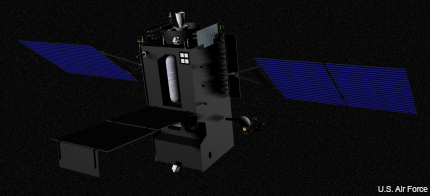Air Force: SBIRS upgrades would cause delays, increase costs
Senate’s proposal to upgrade the early-warning satellites’ sensors could endanger the constellation’s operational capabilities, a report says.

Upgrading the Air Force’s Space Based Infrared Systems satellites could cost upwards of $400 million and might lead to coverage gaps as a result of delays, according to an Air Force report on the matter.
The report, which is titled “SBIRS 5/6 Focal Plane Technology Insertion,” represents the Air Force’s response to technology upgrades proposed by the Senate earlier this year, reports Space News.
SBIRS is viewed as an integral part of the military’s missile early warning and defense systems, and is designed for missile warning, missile defense, battlespace awareness and technical intelligence missions, according to an Air Force fact sheet. The constellation, when completed, will comprise infrared sensor-equipped satellites in both geosynchronous orbit and highly elliptical orbit.
Currently, only the first two satellites of the constellation, GEO-1 and GEO-2, are in orbit—GEO-3 and GEO-4 are still undergoing testing and final assembly, respectively. Lockheed Martin, which has been responsible for the development of the satellites, was recently awarded a $1.86 billion contract to finish production of the last two satellites to complete the system, GEO-5 and GEO-6.
The Senate’s concern, which was detailed in a report associated with the National Defense Authorization Act of 2014, is that the fifth and sixth satellites would be launching with 30-year old sensor technology.
Designed to replace the aging Defense Support Program, SBIRS’ requirements were finalized in 1994. With the launches of GEO-5 and GEO-6 slated for the 2020’s, the sensor technologies used in the satellites will have existed for 20 to 30 years. Subsequently, the Senate inquired about the feasibility of replacing image-recording focal planes with digital focal planes, according to Space News.
The Air Force report found that installing the new technology is feasible, but would add at least $424 million to the costs of the two satellites and push back their delivery by an additional two years, possibly risking the operational capability of the constellation. The upgrade would undo the $1 billion worth of savings the Air Force has expected from buying the satellites in bulk.
The service also contemplated a full-package upgrade that would have involved increasing the resolution of the sensors, as well as upgrading the focal planes. That plan would have required significant design changes, adding $859 million to the cost and a three-year delay to the original delivery date.
“The Air Force does not recommend incorporating these changes due to large cost impacts and resultant schedule slips beyond the operational need dates,” the report said, according to Space News.
The SBIRS program has already suffered from numerous setbacks and cost overruns. The first satellite of the program launched nine years late, and was missing a fully developed ground system, according to a General Accountability Office report released in 2013.
increasedNEXT STORY: Army cyber training center to get new commander

